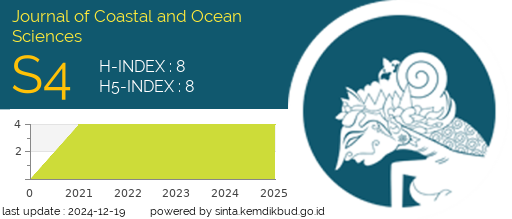Analysis of Lead and Copper Concentrations in Mangrove Clams (Geloina erosa) and Sediments in The North Coast of Bengkalis Island
DOI:
https://doi.org/10.31258/Keywords:
Heavy Metal Lead Copper Geloina erosa Pollution RiauAbstract
This research was conducted in February-April 2021 by taking samples of mangrove clams (Geloina erosa) and sediment from Selat Baru and Teluk Pambang coastal area in Bantan District, Bengkalis Regency, Riau Province. The purpose of this study was to determine the concentration of heavy metals, namely Pb and Cu, in sediment and mangrove clams that are abundant in the studied area. The research method used is the survey method and samples were taken by means of the purposive sampling technique. Heavy metal concentrations were analyzed by using Atomic Absorption Spectrophotometer (AAS). The results showed that the concentrations of Pb and Cu in the mangrove clams and sediments in the studied area had not yet passed the threshold level. Pb and Cu concentrations found on clams were 0.0468 μg/g and 0.1043 μg/g respectively. Meanwhile, the concentration of Pb in the sediment was 0.10185 μg/g and Cu 0.3313 μg/g. Mangrove clams in the north coast of Bengkalis Island have the ability to accumulate Pb and Cu with a low ability (BCF<1). The maximum Tolerable Intake of the clams for humans with a bodyweight of 70 kg is 0.0983 kg/week (Lead) and 7.3010 kg/week for Copper.
Downloads
References
Amin, B. (2012). Pencemaran oleh Logam Berat. Bahan Ajar Ekotoksikologi Lingkungan. Fakultas Perikanan dan Kelautan. Universitas Riau.
Amin, B., B. Irawan, dan Thamrin. (2015). Analisis Kandungan Logam berat Cu, Pb, dan Zn pada Air, Sedimen dan Bivalvia di perairan Pantai Utara Pulau Bengkalis. Dinamika Lingkungan Indonesia 2(1):40-51.
Barokah, G.R., Dwiyitno, dan I. Nugroho. (2019). Kontaminasi Logam Berat (Hg, Pb, dan Cd) dan Batas Aman Konsumsi Kerang Hijau (Perna viridis) dari Perairan Teluk Jakarta di Musim Penghujan. JPB Kelautan dan Perikanan. (14) 2: 95-106.
Connel, D.W., dan G.J. Miller. (2006). Kimia dan Ekotoksikologi Pencemaran. Y. Koestoer (Penerjemah). Universitas Indonesia Press. Jakarta
Dahuri, R., Y. Rais., S.G. Putra., dan M.J. Sitepu. (2001). Pengelolaan Sumber daya Wilayah Pesisir dan Lautan Secara Terpadu. Jakarta: PT. Pradnya Paramita.
Departemen Luar Negeri Republik Indonesia. (2005). “Kebijakan Terpadu Pengelolaan Keamanan Selat Malaka” Medan, 19-20 Juli 2005. Badan Pengkajian dan Pengembangan Kebijakan, Departemen Luar Negeri RI.
Fajri, N.E. (2001). Analisis Kandungan Logam Berat Hg, Cd dan Pb dalam Air Laut, Sedimen dan Tiram (C. cucullata) di Perairan Pesisir Kec. Pedes, Kab Karawang, Jawa barat. Tesis. Pascasarjana IPB.
LaGrega, M.D., Phillip, L. Buckingham, Jeffry C. (2001). Evans and Environmental Resources Management. Hazardous Waste Managemen. Second Edition. New York: McGraw Hill International Edition.
Melinda, M., S.P, Sari., dan D. Rosalina. (2015). Kebiasaan makan kerang kepah (Geloina erosa) di kawasan mangrove pantai Pasir Padi. Oseatek, 9(1):35-44.
Nurdin, J., N. Marusin, Izmiarti, A. Asmara, R. Deswandi, J. Marzuki. (2006). Kepadatan populasi dan pertumbuhan kerang darah Anadara antiquate Arcidae L. (Bivalvia: Arcidae) di Teluk Sungai Pisang, Kota Padang, Sumatra Barat. Jurnal Makara Sains 10(2):96-101.
Ukhty, N., H. Nufus., A. Rozi dan I. Khairi. (2020). Studi Kandungan Logam Berat Pada Kerang Lokan (Geloina Erosa) di Perairan Aceh Barat. Jurnal Pengolahan Hasil Perikanan Indonesia. 23(1): 77-85.
Wanimbo, E. (2016). Pola pertumbuhan respon osmotik dan tingkat kematangan gonad kerang Geloina erosa di perairan Teluk Youtefa Jayapura Papua. Prosiding. Seminar Hasil-Hasil Perikanan dan Kelautan ke VI. Fakultas Perikanan dan Ilmu Kelautan-Pusat Mitigasi Bencana dan Rehabilitasi Pesisir. Universitas Diponegoro, Semarang.
Widowati, I., dan Wahyu. (2008). Efek Toksik Logam. Yogyakarta: ANDI.






